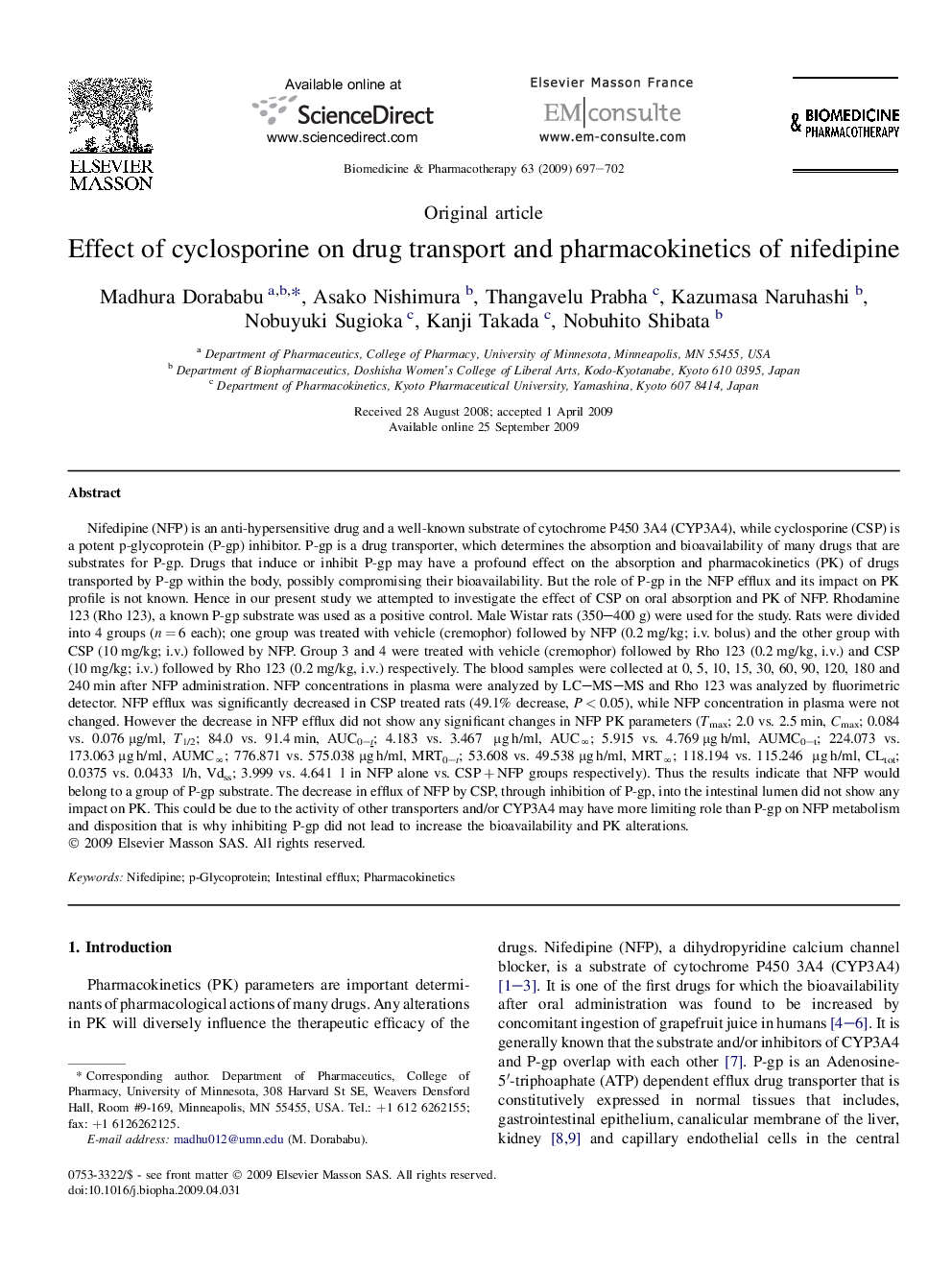| کد مقاله | کد نشریه | سال انتشار | مقاله انگلیسی | نسخه تمام متن |
|---|---|---|---|---|
| 2525218 | 1119602 | 2009 | 6 صفحه PDF | دانلود رایگان |

Nifedipine (NFP) is an anti-hypersensitive drug and a well-known substrate of cytochrome P450 3A4 (CYP3A4), while cyclosporine (CSP) is a potent p-glycoprotein (P-gp) inhibitor. P-gp is a drug transporter, which determines the absorption and bioavailability of many drugs that are substrates for P-gp. Drugs that induce or inhibit P-gp may have a profound effect on the absorption and pharmacokinetics (PK) of drugs transported by P-gp within the body, possibly compromising their bioavailability. But the role of P-gp in the NFP efflux and its impact on PK profile is not known. Hence in our present study we attempted to investigate the effect of CSP on oral absorption and PK of NFP. Rhodamine 123 (Rho 123), a known P-gp substrate was used as a positive control. Male Wistar rats (350–400 g) were used for the study. Rats were divided into 4 groups (n = 6 each); one group was treated with vehicle (cremophor) followed by NFP (0.2 mg/kg; i.v. bolus) and the other group with CSP (10 mg/kg; i.v.) followed by NFP. Group 3 and 4 were treated with vehicle (cremophor) followed by Rho 123 (0.2 mg/kg, i.v.) and CSP (10 mg/kg; i.v.) followed by Rho 123 (0.2 mg/kg, i.v.) respectively. The blood samples were collected at 0, 5, 10, 15, 30, 60, 90, 120, 180 and 240 min after NFP administration. NFP concentrations in plasma were analyzed by LC–MS–MS and Rho 123 was analyzed by fluorimetric detector. NFP efflux was significantly decreased in CSP treated rats (49.1% decrease, P < 0.05), while NFP concentration in plasma were not changed. However the decrease in NFP efflux did not show any significant changes in NFP PK parameters (Tmax; 2.0 vs. 2.5 min, Cmax; 0.084 vs. 0.076 μg/ml, T1/2; 84.0 vs. 91.4 min, AUC0–t; 4.183 vs. 3.467 μg h/ml, AUC∞; 5.915 vs. 4.769 μg h/ml, AUMC0–t; 224.073 vs. 173.063 μg h/ml, AUMC∞; 776.871 vs. 575.038 μg h/ml, MRT0–t; 53.608 vs. 49.538 μg h/ml, MRT∞; 118.194 vs. 115.246 μg h/ml, CLtot; 0.0375 vs. 0.0433 l/h, Vdss; 3.999 vs. 4.641 l in NFP alone vs. CSP + NFP groups respectively). Thus the results indicate that NFP would belong to a group of P-gp substrate. The decrease in efflux of NFP by CSP, through inhibition of P-gp, into the intestinal lumen did not show any impact on PK. This could be due to the activity of other transporters and/or CYP3A4 may have more limiting role than P-gp on NFP metabolism and disposition that is why inhibiting P-gp did not lead to increase the bioavailability and PK alterations.
Journal: Biomedicine & Pharmacotherapy - Volume 63, Issue 9, November 2009, Pages 697–702